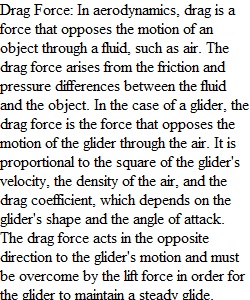


Q Consider the following (simplified) collection of forces acting on a glider aircraft. For a glide angle?=5? and a constant velocity flight path (i.e. no added velocity), estimate the drag and lift forces acting on the glider. Assume a weight force = 3000N. Rubric Modeling Modeling Criteria Ratings Pts This criterion is linked to a Learning OutcomeAccuracy All the ideas used in the diagram and/or narrative correspond to ideas established by the class thus far. (No ideas are used that have not been previously established and agreed on.) 5 pts This criterion is linked to a Learning OutcomeCompleteness All the established ideas and assumptions necessary to explain the event are included in the diagram and/or narrative. (No relevant ideas are missing.) 5 pts This criterion is linked to a Learning OutcomeClarity and Logical Reasoning The presentation is well done so that it flows logically and is easy to follow. It also explicitly connects the relevant ideas to the event being explained. 5 pts Total Points: 15 PreviousNext
View Related Questions